In the Weeds: Shrubs
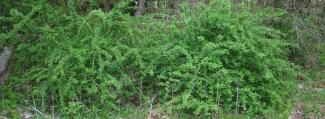
Photo credit: Leslie J. Mehrhoff, University of Connecticut, Bugwood.org.
Unwanted shrubby plants like the Japanese barberry above can easily shade out the selected species in vegetated stormwater systems. Click on the plant names below to open a dropdown with images and more information about each of these common GI invaders.
Scientific name: Euonymus alatus
Status: Invasive
This large shrub can grow up to 10 feet tall and wide. Leaves turn a striking bright red in fall. Branches are green-brown with flaky “wings” and the small red fruits are eaten by birds. Has opposite leaves with toothed edges.
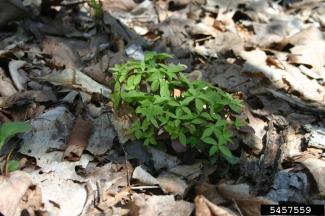


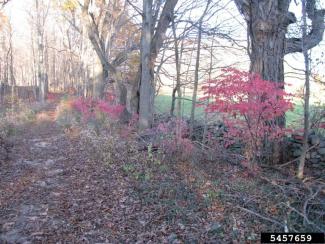
Photo credit: Leslie J. Mehrhoff, University of Connecticut, Bugwood.org.
Scientific name: Euonymus alatus ‘Compactus’
Status: Invasive
Dwarf-winged burning bush is a smaller, slower-growing variety of burning bush used commonly in landscaping. It differs because of its thin green twigs and much harder to discern “wings”. ‘Compactus’ also has opposite leaves with toothed edges.
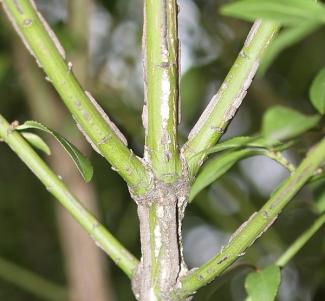
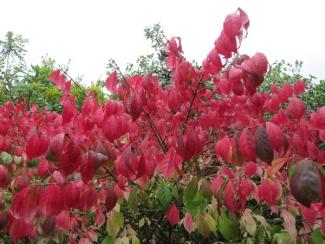
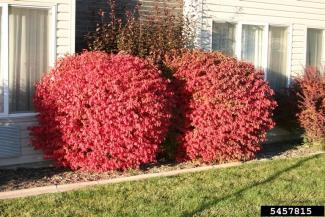
Photo credit: (First) Maggie CC BY-NC-2.0, (second) Leonora Enking CC BY-ND-2.0, (last) Leslie J. Mehrhoff, University of Connecticut, Bugwood.org.
Common Barberry
Berberis vulgaris
Invasive
Common barberry can reach 10 feet in height. It has toothed, simple leaves, three-pronged spines and yellow flowers that develop into fleshy berries.
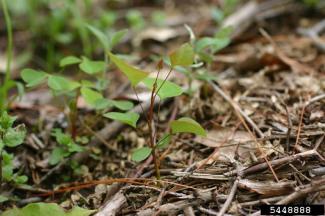
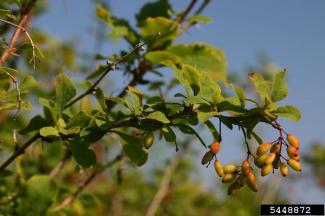
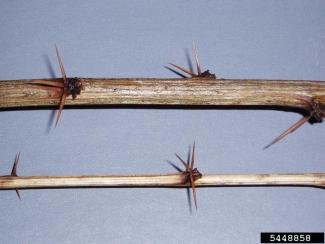
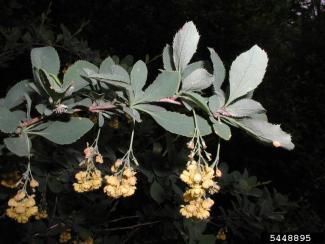
Photo credit: Leslie J. Mehrhoff, University of Connecticut, Bugwood.org.
Japanese Barberry
Berberis thunbergii
Invasive
Ranges from 3-6 feet in height. Japanese barberry has dense growth pattern and one spine per node. Unlike Common barberry, the edge of leaf is smooth. Berries are chalky.
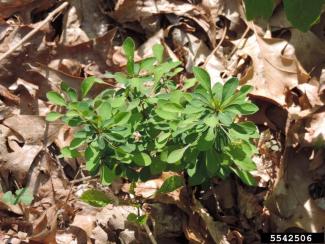
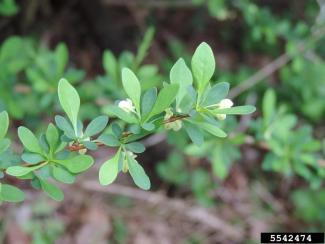
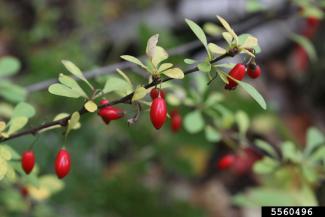
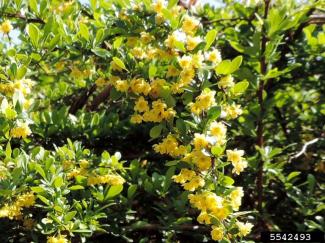
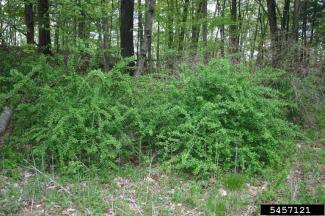
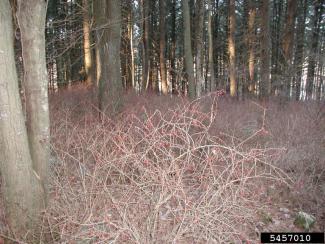
Photo credit: (First, second, fourth) Richard Gardner, UMES, Bugwood.org, (third) Chris Evans, University of Illinois, Bugwood.org, (fifth, sixth) Leslie J. Mehrhoff, University of Connecticut, Bugwood.org.
Common Buckthorn
Rhamnus cathartica
Invasive
Common buckthorn is a thorny plant that forms dense thickets. It has dark fruits, and leaf veins curve in so that they are somewhat parallel to each other. Leaf edge is toothed. Be sure that leaves are arranged opposite to tell apart from similar-looking native plants.
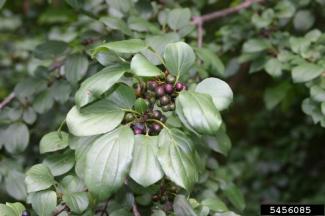


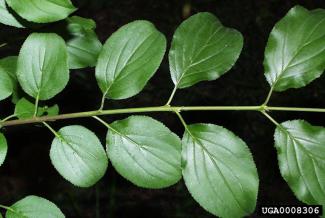
Photo credit: (Top, second, third) Leslie J. Mehrhoff, University of Connecticut, Bugwood.org, (fourth) Paul Wray, Iowa State University, Bugwood.org.
Glossy False Buckthorn
Frangula alnus
Invasive
Has shiny leaves and small white flowers. Berries ripen from green to red to blue-black. Glossy buckthorn grows in the shade under trees. Be sure that leaves are arranged alternate and leaf edges are smooth to tell apart from similar-looking natives plants.
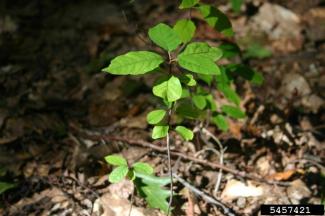
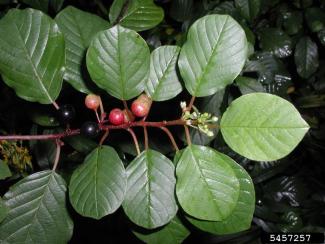
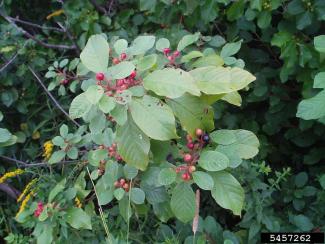
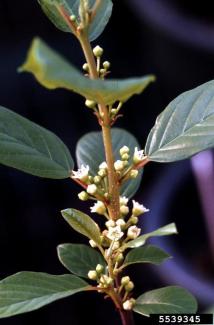
Photo credit: (First, second, third) Leslie J. Mehrhoff, University of Connecticut, Bugwood.org, (fourth) Davis Sydnor, The Ohio State University, Bugwood.org.
Gray Willow
Salix cinerea
Invasive
Leaves are simple and edges are smooth. On young plants the leaves have fine silver hairs on their underside, which fade as plant gets older and bigger. Native willows have flat leaves while the leaf margins roll under on gray willows (see fourth image below). Peeling bark off a twig and to reveal fine, white, vertical ridges underneath is another way to tell a gray willow from native pussy willows.
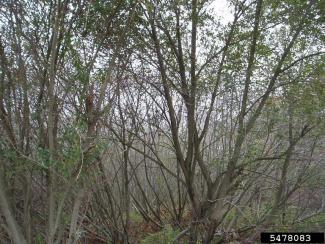

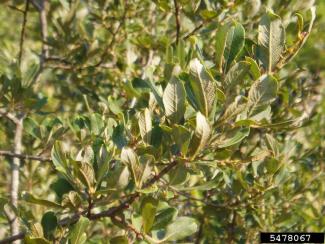
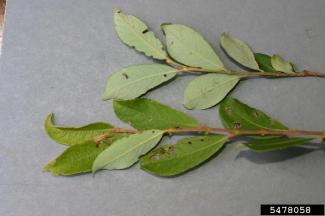
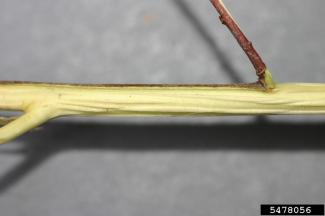
Photo credit: Leslie J. Mehrhoff, University of Connecticut, Bugwood.org.
Heather
Calluna vulgaris
Invasive
Heather is known for its many purple flowers. It is a low shrub that grows close together with leaves that remain green through winter. Has two leaves per node and edges of leaves can have teeth or be smooth.
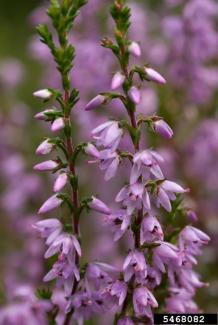
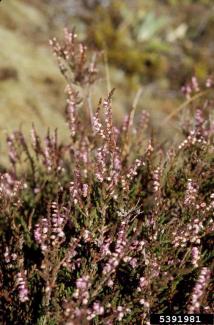
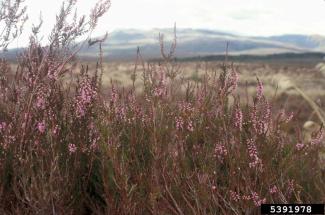
Photo credit: (First) Dan Aamlid, Bugwood.org, (second, third) John M. Randall, The Nature Conservancy, Bugwood.org.
Amur Honeysuckle
Lonicera maackii
Invasive
Flowers are fragrant and appear late in May. The flowers are white at first and turn yellow as they age. Leaves are arranged opposite and come to narrow tip.
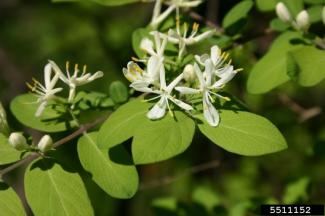
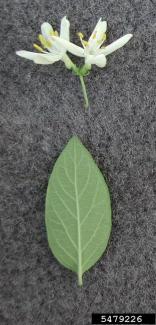
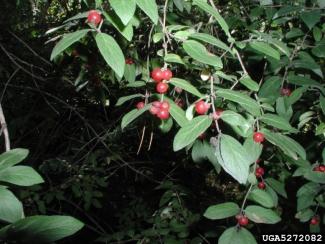
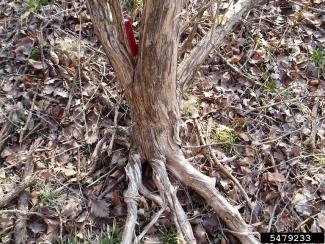
Photo credit: (First, second) Richard Gardner, UMES, Bugwood.org, (third) T. Davis Sydnor, The Ohio State University, Bugwood.org, (fourth) John Hilty, Illinois Wildflowers.
Morrow’s Honeysuckle
Lonicera morrowii
Invasive
Flowers are white-pink and finely-hairy. Leaves are hairy on underside with smooth edges. Often found in shade under trees.




Photo credit: Leslie J. Mehrhoff, University of Connecticut, Bugwood.org.
Showy Honeysuckle
Lonicera x bella
Invasive
This plant can reach up to 20 feet tall. Leaves are arranged opposite and are widest at or below middle, with short hairs on underside. Leaves are arranged opposite. Flowers develop in pairs. Unlike Amur and Morrow’s honeysuckle it can grow in full sun.
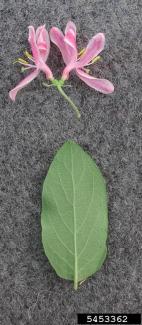
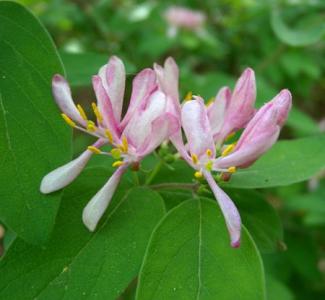
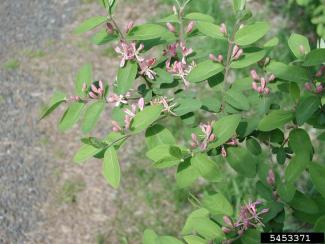
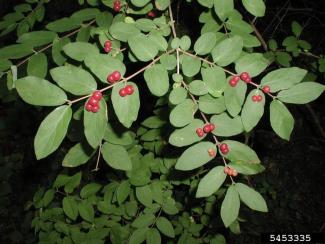
Photo credit: (First, fourth) Leslie J. Mehrhoff, University of Connecticut, Bugwood.org, (second, third) John Hilty, Illinois Wildflowers.
Tatarian Honeysuckle
Lonicera tatarica
Invasive
Tatarian honeysuckle has thick tangles of leafless branches. It usually has many pink flowers which are strongly asymmetrical. Leaves have smooth edges that end in blunt point.
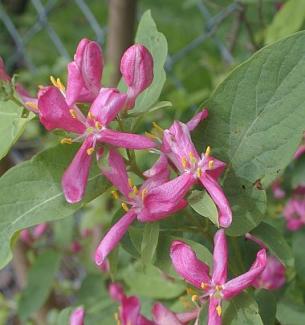
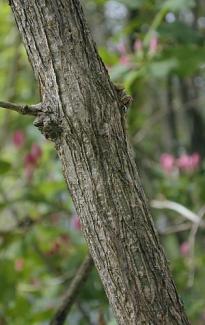
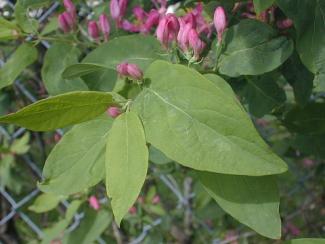
Photo credit: John Hilty, Illinois Wildflowers.
Japanese Beach Rose
Rosa rugosa
Invasive
Most often found on or near coastal dunes. Has rough, toothed leaves, pink flowers, and orange-to-red fruits called hips. The hips are 1” or more in size, larger than native rose hips. Japanese beach rose can spread by putting down roots where branches touch the ground.
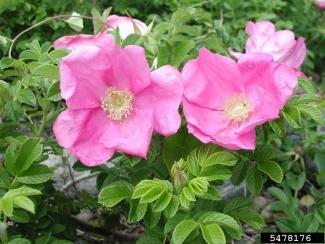
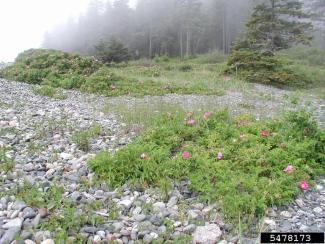
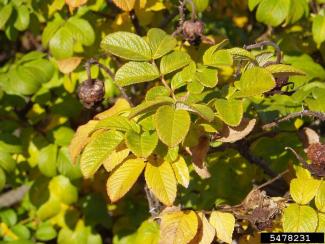
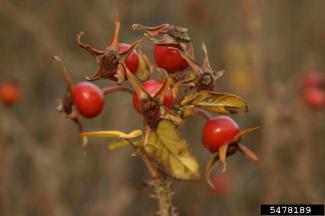
Photo credit: Leslie J. Mehrhoff, University of Connecticut, Bugwood.org.
Multiflora Rose
Rosa multiflora
Invasive
Has thorny, arching stems that can root at tips. Leaves are compound and toothed, and flowers are white. Fruits are noticeably smaller than those of Rosa rugosa. Distinguish from native species by confirming that stipules are fringed like eyelashes, as in third image below.
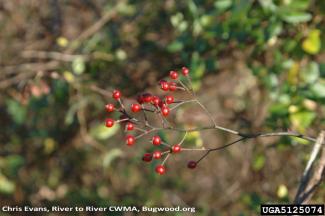
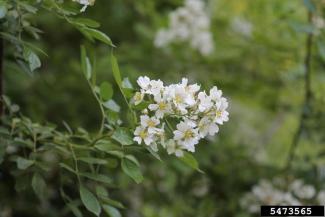
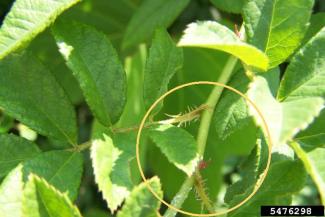
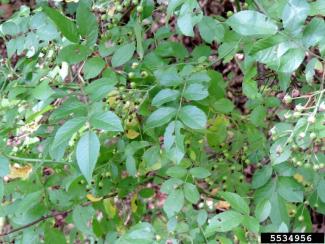
Photo credit: (Third) Rob Routledge, Sault College, Bugwood.org, (fourth) Karan A. Rawlins, University of Georgia, Bugwood.org, (fifth) Richard Gardner, UMES, Bugwood.org.
Autumn Olive
Elaeagnus umbellata
Invasive
Leaves are simple and edges are smooth. This plant is hardy with clusters of light-colored flowers. Red berries ripen in the fall. Spikes rise off of smooth-barked branches. The undersides of the leaves are silvery.
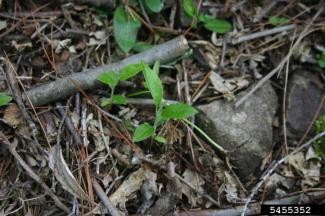
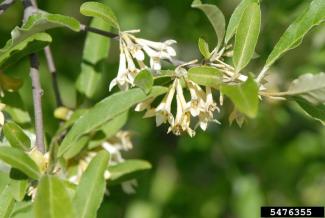

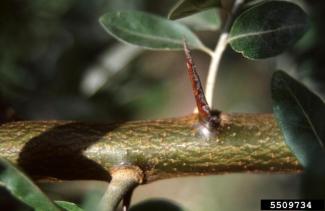
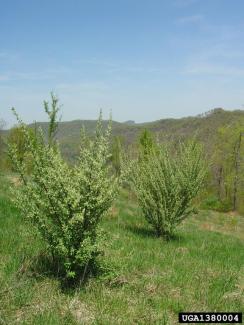
Photo credit: (First, third) Leslie J. Mehrhoff, University of Connecticut, Bugwood.org, (second) Kathy Smith, Ohio State University Extension, Bugwood.org, (fourth) T. Davis Sydnor, The Ohio State University, Bugwood.org, (fifth) Chris Evans, University of Illinois, Bugwood.org.
Russian Olive
Elaeagnus angustifolia
Invasive
Found in moist soils, it has narrow silvery-blue leaves, yellow flowers, and olive fruits. The bark of young trees is shiny brown and smooth (similar to autumn olive above) and on older trees appears in long loose strips. Leaf edges are smooth.
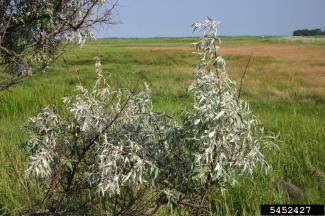
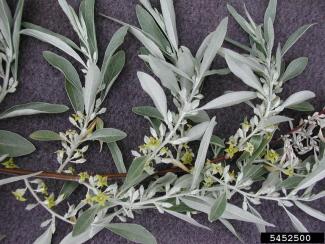
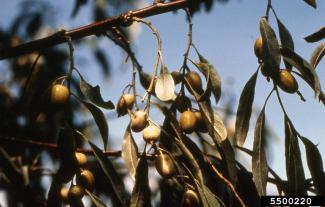
Photo credit: (First, second, third) Leslie J. Mehrhoff, University of Connecticut, Bugwood.org, (fourth, fifth) Davis Sydnor, The Ohio State University, Bugwood.org.
Privets
Ligustrum spp.
Invasive
Several species of privets are locally invasive. All have clusters of white flowers with short anthers, developing into dark fruits. Leaves are generally glossy with smooth edges, and are partially evergreen (or green year-round). Privets can reach 30 feet in height.
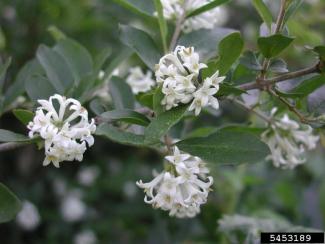
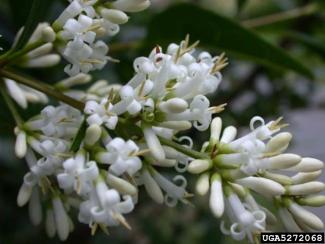
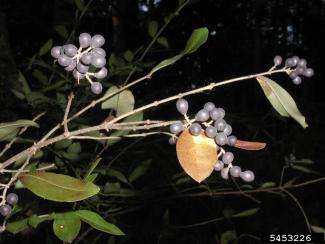

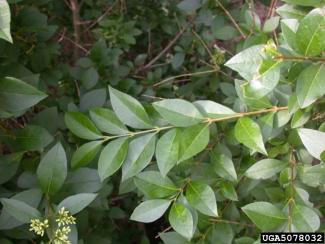
Photo credit: (First, second, third, fourth) Leslie J. Mehrhoff, University of Connecticut, Bugwood.org, (fifth) Richard Gardner, UMES, Bugwood.org, (sixth) Nava Tabak, Invasive Plant Atlas of New England, Bugwood.org.
Descriptions for Burning Bush, Common Barberry, Japanese Barberry, Common Buckthorn, Glossy False Buckthorn, Gray Willow, Heather, Amur Honeysuckle, Morrow’s Honeysuckle, Tatarian Honeysuckle, Japanese Beach Rose, Autumn Olive, Russian Olive, and Privets obtained from New England Wild Flower Society. www.newenglandwild.org & www.gobotany.newenglandwild.org
Description for Showy Honeysuckle referenced from www.illinoiswildflowers.info/trees/plants/shw_honeysck.html
Description for Multiflora Rose referenced from https://extension.umd.edu/hgic/
